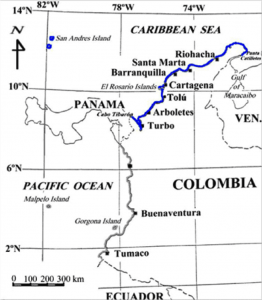Hector Fernandez-L’Hoeste teaches Latin American Cultural Studies at Georgia State University in Atlanta, Georgia. He was born in Barranquilla, Colombia, and writes frequently about cumbia and its impact around the Americas. He is the editor of an upcoming anthology about the cumbia diaspora titled “All the Cumbias,” to be published by Duke University Press.
Marlon Bishop: To start off – why are we talking about Cumbia? Why is it important?
Hector Fernandez-L‘Hoeste: Cumbia is important because basically at this point it’s the most popular genre in the Americas. In the US, pretty much everywhere you find a Latino population you’re going to find a following for cumbia. You certainly have Mexico completely covered. Central America, Panama and all the Andean nations have a local form of cumbia from Venezuela all the way to Chile and even in places where you wouldn’t expect to have a strong tropical music tradition - places such as Argentina or Uruguay - you do have a following for cumbia. It’s all over the place. Why? One reason is that it has a relatively flexible and simple musical structure that allows people to embrace it, and modify it a little bit and create their own variety. That’s part of the secret of cumbia’s success.
MB: Give us a little bit of background on cumbia’s development in Colombia.
HFL: Overall people agree that cumbia must’ve started somewhere near Cartagena, the seaport on the Colombian Caribbean. Colombia was sort of a backwater. It wasn’t a priority in Spanish rule. You had cities that were centers of power, but out in the country, there was almost a complete lack of the presence of the state, which [led to] things like the slaves living on their own in what would be called palenques, small towns organized and ruled by the slaves. Originally, cumbia and other Afro-Colombian rhythms came out of those types of communities.
Cumbia in the twentieth century was the process of being influenced by the big band period. Slowly as American culture started gaining influence in Colombia, a series of musicians decided to adopt the big band model, developing stylized forms of cumbia. In a way it was a measure to have other audiences in the larger cities inland, like Medellín and Bogotá, cities with a very different sensibility. Through that process, Cumbia is embraced by the middle class and the upper classes. But we could say by the fifties, early sixties, cumbia had already become the national form. Those are mainly through the orchestras of Lucho Bermudez and Pacho Galan.
MB: Was this the same time that cumbia became popular outside of the country?
HFL: No, not quite yet. Bermudez and Galan, they did tour a little bit. But it was a sound that was too Colombian for it to be easily embraced abroad. They traveled to Mexico, they traveled to Central America, they traveled around the Caribbean, they even traveled to the States, so they were known abroad. But they did not feed the fire of cumbia internationally the way the forms of chucu chucu did later on.
MB: Chucu chucu? What was that?
HFL: I’ll explain. In the 60s, modernity starts arriving to Colombia. The recording studios are moving from the coast, from where cumbia was originally created, to Medellín and Bogotá and in the process of technology being incorporated. So with the arrival of technology, forms are created that explore a more efficient way of creating cumbia. There is no longer a need for the huge band, which is more costly. You could have a much smaller ensemble and you could incorporate organs and electric guitar.
Out of this, a new kind of cumbia arises which Colombians at first called “chucu chucu,” because that’s literally the way it sounded - ch, chchch, chchch. It was the sound of the guacharaca, a tube that you basically scratch, like a guiro. The end result was this very simple rhythm. It’s a sound that almost anyone without formal schooling can embrace, and immediately start playing. And you know, that’s a huge appeal. The beauty of it all is that it gives a voice to people that initially did not have a voice. But musicians from the coast, they strongly disliked what was beginning to happen to cumbia.
MB: Why was that?
HFL: If you listen to traditional cumbia – Toto La Momposina – if you watched the way it’s danced, it has not much to do with chucu chucu. The rhythm is much more complex. But they did take that structure, and it evolved in such a way that engendered the chucu chucu, but that wasn’t the initial idea.
MB: But this was the music that came to define the sound internationally…
HFL: Yes. It was created from the beginning with the idea that we have to market a product that can be exported, a product that takes a national form and puts it in, develops it into a generic package, and that generic package can be sent abroad.
But let me backtrack for a second. When cumbia went abroad, it was interpreted and viewed as a working class genre. So to that extent, it wasn’t viewed as a cultural imposition, it wasn’t viewed as intrusive. There was no agenda behind it. Why? Because it was basically coming from Colombia, which had never been identified within the context of Latin American culture as having a political plan. It didn’t have a cultural industry Mexico had, it lacked the expansionist plans the Brazilians had, and it lacked the Eurocentric traditions Argentines had.
So it was sort of allowed to penetrate, to come into certain contexts in the Americas, and once it arrived, generally speaking, what happened was the corresponding working class embraced cumbia, and pretty soon figured out how to modify it slightly and allowed local musicians to create forms that were perhaps easier to digest for their national crowds. Its origin was irrelevant. What was relevant was that it conveyed this idea of the tropics, and that idea of the tropics could be consumed and it could be adapted to a local context. In this way you had Mexican cumbia, Chilean cumbia, Peruvian cumbia, so that’s more or less, you know, in a sort of summarized fashion, the way cumbia traveled throughout the Americas, at least initially.
MB: Can you explain that idea of a national agenda a little more?
HFL: Like we do in the states to sell American culture, there is a certain awareness that by selling American culture, certain values, certain morals are being supported and are being distributed. Mexico does the same thing. In the Colombian case, there was no such thing. There no such thing as a set of Colombian ways of values, or a Colombian way of life, or a Colombian identity associated with a government that was linked to this music. The Colombian labels were aware of what was happening when they were exporting cumbia. The only thing is that they didn’t care about national identity. All they cared about was the bottom line. And it was selling like hotcakes.
MB: Where did cumbia take off first?
HFL: Cumbia penetrated Mexico almost a decade before it arrived in the Andean countries. In Colombia you will find Mexican culture was very important. So the idea of exporting Colombian music to Mexico was very appealing. You have to remember, Mexico has always been one of the cultural capitals of Latin America. So you have always had this demand for big tropical bands in Mexico City. Remember - mambo was created in Mexico, by Cuban musicians living in Mexico City. Elsewhere, the markets were not as big. Lima and Quito urbanize around the same time as Bogotá, but by the time Bogotá urbanizes, Mexico City is already a monster. So Mexico had the audience, and it justified the traveling, or the exporting of music towards marketing it all the way from Colombia.
MB: Could you describe the Mexican cumbia scene today?
HFL: Well, Mexico has become a hotbed of fusion and hybridity, so it’s very interesting to see young ensembles, even rock groups, and see them incorporate cumbia with touches of pop, with touches of accordion, with distinct undertones of Mexican popular music, but still recognizable as cumbia. It’s very hard to single out one particular way of cumbia being embraced in Mexico. There are so many.
MB: I’m particularly interested in the cumbia scene in Monterrey, in Northern Mexico. Can you tell me a little about that?
HFL: Well particularly in Northern Mexico, not only did they like cumbia, they identified with it so much that they decided that they could master it in such a way that they could generate a Mexican form of this music that is recognizable as Colombian too. In Monterrey, there is such a thing about talking about “musica Colombia”, or even being a “Colombia”. It’s a different way of playing Colombian music with a strong Mexican sensibility – the most famous example is the musician Celso Piña.
MB: That’s really interesting – how did this subculture emerge?
HFL: Well there are many things that can be said. You have to consider for one when this music arrives, it’s from the Caribbean Coast, a region on the periphery that has a strong tension with the center. So when this music arrives to the northern part of Mexico – which is a region that prides itself on having a strong identity independent from Mexico City, a region that is very comfortable crossing the border, with a certain lack of respect for that border, and is very comfortable consuming products from north of that border – when that music arrives from Colombia and it has all those elements, it strikes a chord of commonality. It is people in northern Mexico, who to a large extent viewed it as, “well it’s music that expresses a lot of things that we also feel”.
Also, it has a strong working class context. To musical eyes it’s not consumed or viewed as Mexicans as music of African descent, or Caribbean descent, or mixed descent, it’s basically the class context. In Monterrey, the “colombias” are kids that come from el barrio, that is, from working class neighborhoods. So they see this music, they see that they can play it with an accordion, and they embrace it.
MB: What are some other examples of the “Cumbia diaspora”?
HFL: Well, one fascinating iteration happens in Argentina, around the time of the financial crisis. It’s called cumbia villera. When one thinks of Argentina, one doesn’t think of a tropical place. One doesn’t think of a place with a large population of African descent. Buenos Aires had a large Afro-Argentinean population until the mid-1800s. Nowadays, if you go to Buenos Aires, you might find some communities of African descent, but it’s minimal.
Yet when cumbia was taken into the working class neighborhoods of Buenos Aires, it was embraced by that which the Argentines called the negros or “the blacks,” but not meaning someone of African descent – no such thing. The word just referred to poor working people. What the label “black” referred to, in a very racist way, was the idea that blacks, or people of African descent, belong to the lower social order. If somebody wanted to embrace a strong working class identity, and establish that they were proud of that heritage, they could label or call themselves negros. Those negros were the ones that embraced cumbia.
MB: So how does this music relate to the financial crisis?
HFL: The rise of cumbia villera is after the fall of the Argentinean economy. All of a sudden you have a sizable portion of the Argentine population no longer identifying themselves as middle-class; all of a sudden they’re viewing themselves as poor. And here comes a cultural product that addresses that new sensibility. Villera addresses themes, topics, having to do with that new reality. They sing about robberies, sexually explicit lyrics, and drugs, and Argentina wasn’t used to that.
MB: Villera, of course, referring to the villas or shanty-towns surrounding Buenos Aires…
HFL: Yes. Villera makes Argentines, in many cases for the first time ever, have to deal with something from a portion of the reality that they don’t want to deal with, the poor slums around Buenos Aires. They don’t even want to admit that it’s another Argentina and it’s another Argentina that matters. So to that extent cumbia villera is a very important cultural product.

The cheto, the middle-class snob from downtown Buenos Aires, is viewed by these kids from the slums as having the entire social and governmental order on his or her side. And the kids from the slums don’t see that legal order as legitimate, as something that has backing behind it. They view the national order as something so intrinsically corrupt that they fail to identify the difference between them breaking the law and the ruling classes robbing from the poor for generations. They just don’t see the difference. As Argentineans it’s also their right to infringe the law and disrespect the order the way more privileged sectors have done in the past. So that’s what they’re trying to express with the cumbia villera.
MB: What’s happening today with cumbia back in Colombia?
The interesting thing about cumbia is as I’ve said before how flexible it is to adapt. Now there are a lot of new bands looking back into the Afro-Colombian roots and bringing it into modern music – Bomba Estereo, for example – bands that are beginning to sell even in the States. They take traces of music that allude to the form of Colombian identity that came from the countryside, and they play in a way that appeals to younger generations, yet they emphasize the African content.
Which is not what Carlos Vives, the vallenato star, did a decade earlier. What Vives does is he takes cumbia, which has already gone through a process of whitening as it goes from the coast to the interior, and he whitens it even further because he incorporates a rock sensibility into it. These new bands that I just mentioned go back and they take that African heritage, and they incorporate a contemporary sensibility and new instruments but they emphasize the African heritage.
MB: And what’s the big picture here? What does the cumbia story teach us?
HFL: I would have to say that the story of cumbia is the story of sectors of society that have been forsaken by the national order finding an alternative means of representation. What all these forsaken groups are trying to celebrate is that there’s another way of being national, and it doesn’t have to go through the government, and this is my way. And just as it happened in the Colombian case, because after all cumbia came from a place that is despised by the government, by the elite of the country, and ironically took over the whole country. So it happens in other latitudes and corners of Latin America.














